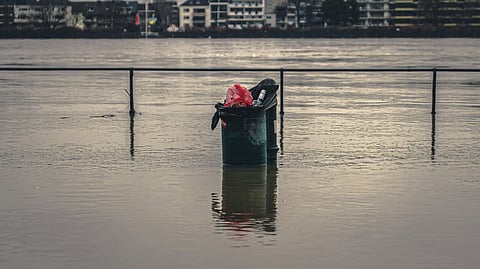Insurance Challenges Down Under: Navigating a World of Rising Premiums
Australians are grappling with a significant insurance gap, leaving homeowners and businesses vulnerable. They face the dual threat of inadequate insurance coverage in the event of a disaster and the rising cost of premiums, even for those living far from high-risk zones. This is part of a broader global trend, worsened by the effects of climate change.

Compounding climate risks are driving higher insurance premiums for all Australians — not just those in disaster zones.
This insurance gap has serious implications, particularly for those seeking mortgages and homeownership, especially in a world where climate-related disasters are increasing.
In 2022, catastrophic floods in Queensland and New South Wales resulted in insured losses exceeding $6 billion. Shockingly, roughly 48% of Australian losses were uninsured.
The Burden on Everyday Australians
Everyday Australians are encountering substantial increases in insurance premiums. The number of people experiencing insurance stress has risen from 10% in 2022 to 15% last year. Many individuals in vulnerable areas are underinsured or entirely uninsured, and even those with coverage are paying significantly more.
The Global Impact of Disasters
Globally, a climate or extreme weather-related disaster has been recorded almost every day for the past 50 years, causing an average of 115 deaths and US$202 million in losses. Concerns extend beyond the immediate costs of recovery to include the challenges of rebuilding to withstand future losses.
In advanced economies, insurance is often presumed to cover rebuilding costs. However, the disaster insurance protection gap leaves many people without coverage and with no identified financial resources for recovery.
The recent Los Angeles fires, for example, caused an estimated US$250 billion in economic losses. However, only $40 billion was covered by insurance.
Why the Protection Gap Exists
Australia’s insurance gap mirrors a global one. The global disaster insurance protection gap, meaning the shortfall in funds for recovery, is estimated to be around US$1.8 trillion.
Several factors contribute to this gap:
- Uninsured Losses: Certain losses, such as those affecting infrastructure and government-owned assets, are typically not insured.
- Lower-Income Countries: Countries with less developed insurance markets also contribute to the gap.
- Emerging Threats: Newly emerging threats like cyber risks are not yet fully understood or modelled for insurance purposes.
A Growing Problem
This protection gap is becoming increasingly problematic in economies where most homeowners were once assumed to be insured. Now, underinsurance and a lack of insurance are common in many locations. There are three key reasons for the gap:
- Risk-Reflective Pricing: Insurers charge higher premiums for properties with a higher likelihood of incurring losses. This is based on past losses and proximity to, or location in, high-risk zones.
- Insurance as a Pooling Mechanism: Insurance works by spreading risk. As disasters become more frequent and severe, more premium capital is needed to cover the costs of the many.
- Climate Uncertainty: Fluctuations linked to climate change, sometimes called “weather weirding” or “whiplash,” increase volatility in the insurance market from unforeseen losses. The uncertainty leads to higher capital reserves for both insurers and reinsurers, which results in increased premiums.
Why This Matters
The insurance protection gap prevents capital from flowing globally to rebuild homes in local economies after disasters. Without sufficient insurance, the burden of recovery falls heavily on those who are already financially and socially vulnerable.
Moreover, being unable to obtain insurance often prevents people from securing mortgages, which is a serious issue given homeownership’s critical role in Australian wealth accumulation.
The broader societal costs are also significant, as government disaster funds cover expenses like temporary housing and rebuilding efforts.
Looking Forward: Potential Solutions
Addressing the insurance gap necessitates a two-pronged approach that addresses financial burdens and the physical risks associated with disasters.
- Government-Legislated Insurance Mechanisms: These mechanisms, known as protection gap entities, can subsidize those at high risk to keep them in the insurance pool. The cyclone pool in Australia serves as an example, providing a guarantee that helps insurance companies offer policies.
- Multi-Peril Protection: These entities need to be compulsory to make sure that the entire population is covered and to offer multi-peril protection that addresses all key hazards.
Risk Reduction: Addressing the Underlying Problems
Reducing risks is another key step. In the UK, the entity focusing on flooding is working with insurers to ensure properties are rebuilt with increased flood resilience.
The Swiss public sector insurance system further includes preventive measures to minimize losses during disasters.
Australian Options
The most effective solutions are complex. Australia is considering various measures, and the insurance sector is requesting an investment of $30 billion in flood resilience. Both the federal and some state governments are investing in resilient housing programs at different scales.
The existing cyclone reinsurance entity provides a foundation for a broader pooling mechanism that integrates insurance and resilience measures.
Professor Paula Jarzabkowski is one of the leads of the Practice and Process Studies research hub and a professor in strategy at The University of Queensland’s School of Business. Her research is backed by the Australian Reinsurance Pool Corporation, Natural Hazards Research Australia, and the Queensland Reconstruction Authority. She is also a member of the OECD High-Level Advisory Board for the Financial Management of Catastrophic Risk and on the Pool Re Advisory Board.


